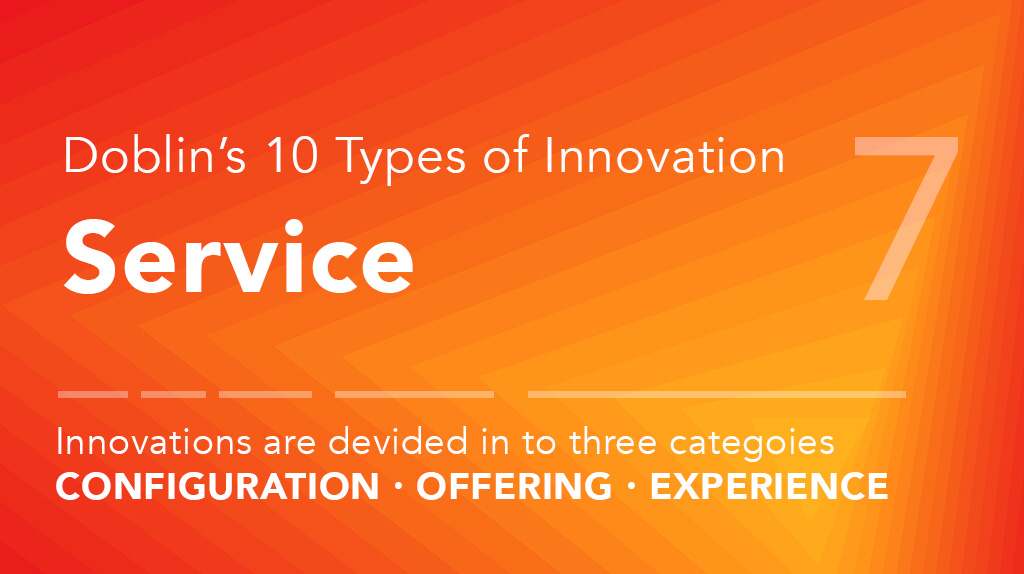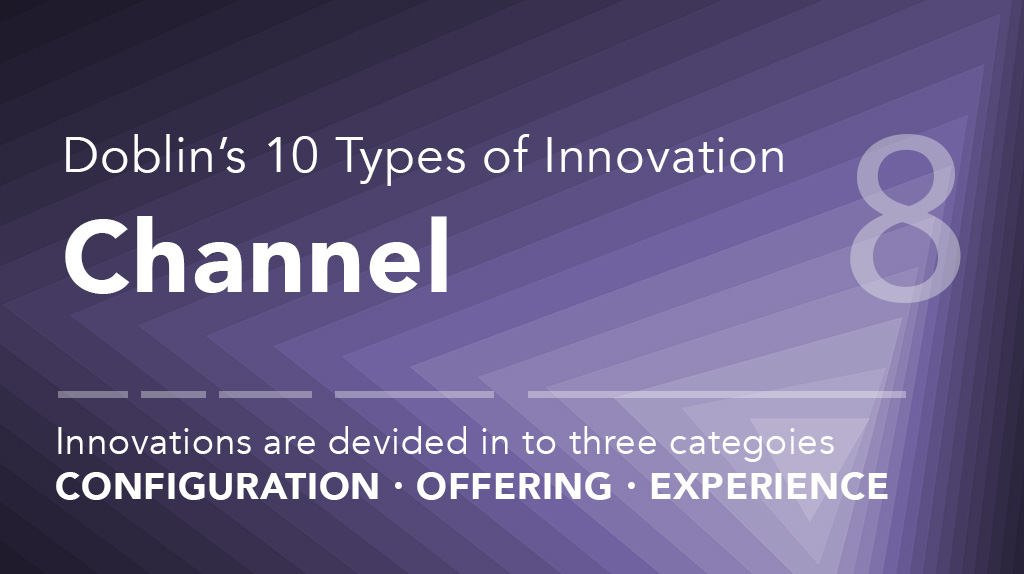Intro
In this series of posts, we will be inspecting Doblin’s 10 Types of Innovation, a popular framework for analyzing innovations in business developed by the Doblin Innovation Firm in Chicago. Innovations are divided into three categories: configuration, offering, and experience. Configuration focuses on the innermost workings of an enterprise and its business system, offering focuses on an enterprise’s core product or service, and experience focuses on customer-facing elements. In this post, we will analyze the first block in experience, service innovation.
Definition
Service Innovation is essentially about how you support and amplify the value of your offerings. Doblin defines service innovation as:
“Service innovations ensure and enhance the utility, performance, and apparent value of an offering. They make a product easier to try, use, and enjoy; they reveal features and functionality customers might otherwise overlook; and they fix problems and smooth rough patches in the customer journey. Done well, they elevate even bland and average products into compelling experiences that customers come back for again and again.”
Service innovations all revolve around the customer and making their experience using your product or service easier, hence the idea of “customer service.” Anything helps clients use a product, understand its various features, or elevate their engagement with it all falls under the banner of service innovation. True service innovation will set a product and its company apart from its competitors.
Examples
There are seemingly infinite ways that organizations can innovate their support and supplemental servicing of their primary offer due to the definition of “service” being quite wide. As a result, service innovations can be all over the map and even overlap with other innovations. Examples of service innovation include:
- Product Use Enhancements – additional or complementary features and experiences to elevate the customer experience surrounding a product or service
- Customer Support – providing assistance to customers regarding planning, installation, training and education, troubleshooting, maintenance, upgrading, and disposal of a product or service
- Personalized Service – harnessing an individual’s specific preferences to provide tailored service and concierge-like requests
- Loyalty Programs – a system in which customers are incentivized to buy even more due to special perks, rewards, and points
- Warranties – promises from companies to repair or replace if necessary within a specified period of time
- Guarantees – assurances that a product or service will be refunded if they fail to meet expectations
For this blog post, we will focus on examples regarding product use enhancements, customer support, and personalized service.
Product Use Enhancement Examples
These service innovations enhance the customer experience by complementing it with added value.
Nike is an American multinational corporation that designs and manufacturers footwear, apparel, equipment, accessories, and services. At their flagship store in New York City, Nike launched The Speed Shop, which allows customers to order shoes online, try them on in-store via a shoe locker that can be unlocked with a smartphone, and then finish with a mobile checkout that doesn’t require interacting with an employee. The result is a fast and easy shopping experience for shoppers who already know what they want.
Sysco is an American multinational corporation involved in marketing and distributing food products, smallwares, kitchen equipment, and tabletop equipment to restaurants, healthcare and educational facilities, and hospitality businesses. In order to elevate service in a relatively commoditized industry, Sysco began providing clients with a free consulting service called “Business Reviews” that helps them design menus and plan back-of-the-house logistics. This additional service has proven valuable for customers and has helped Sysco maintain its position as one of the largest food distributors in North America.
Amazon is an American multinational technology company that focuses on e-commerce, cloud computing, digital streaming, and artificial intelligence. Their AmazonSmile program donates 0.5% of all purchases made through their e-commerce platform to the charity of the user’s choice (over 1 million available to choose from). It provides customers with a simple way for them to donate to their favorite charitable organizations at no extra cost, adding value for customers who care about contributing to charity.
Kroger
Kroger is an American retail company that operates one of the largest supermarket chains in the country. Kroger is experimenting with a new smartphone app called Scan, Bag, Go that allows shoppers to scan items as they shop and skip the checkout process by paying on the app. This app allows more flexibility for customers, as it shows you running totals and saves time from long checkout lines, and also provides Kroger with the opportunity to directly show coupons and offers.
Customer Support
These service innovations go above and beyond in helping customers plan, install, train, learn, troubleshoot, upgrade, and maintain a product or service.
Zappos is an American online shoe and clothing retailer that was a key pioneer in e-commerce customer service, empowering customer service representatives to go above and beyond and “deliver WOW through service.” Representatives often take extraordinary action on behalf of customers, like sending shoppers flowers, troubleshooting with customers on the phone for hours to find the perfect pair of shoes, or even buying from competitors on Zappos’s tab if a certain product is out of stock. This exemplary customer service is part of the reason Amazon acquired Zappos in 2009 and what allowed for Zappos to spin off a consultancy that helps other companies overhaul their customer service, Zappos Insights.
Mercedes-Benz is a German automotive subsidiary of Daimler AG that produces luxury and commercial vehicles. Because car manuals are notoriously big and bulky, Mercedes launched the Mercedes Me app, which showcases a car’s features without requiring drivers to read the manual. This interactive approach helps engage customers more while also providing them with a platform that enhances “smart” ownership, with features like service reminders and remote parking assist.
Whole Foods is an American multinational supermarket chain known for selling products free from artificial colors, flavors, and preservatives. In order to help customers find new recipes and ways to use ingredients found in Whole Foods stores, Whole Foods created a powerful chatbot to help inspire meal ideas — or, if customers are really in a rush, they can simply send an emoji and instantly get a recipe back. This kind of customer service helps Whole Foods get feedback on what kind of foods customers are looking for while also adding value for customers by helping them plan and learn their groceries.
Personalized Service
This type of service innovation goes above and beyond the standard customer service model, tailoring service to an individual and providing ancillary support for concierge-like requests.
Harrods is a British department store located in London and is one of the most famous department stores in Europe. Harrods’s motto is “Omnia Omnibus Ubique” (“All Things for All People, Everywhere”), leading to their reputation of being able to source anything for its customers (even gold bars). This is a classic example of “halo services,” services that may be used infrequently but can be invaluable to people’s perception of a company.
Brideside is an online retailer that sells designer bridesmaid dresses and accessories for the entire bridal party. Because many brides have a hard time finding dresses that are flattering on all their bridesmaids, Brideside uses personal stylists to make professional recommendations. Not only does this help reduce stress on the bride and bridesmaids, it’s exactly the kind of personalized service people respond to when using one-time services.
Cleo
Cleo is a London-based company that created an app and chatbot that they hope will eliminate banking apps. Customers chatting with the bot can easily track their spending, budget, and get financial advice. Cleo takes the approach of trying to build trust with customers by taking on the role of a good friend who can offer information and advice tailored to you, presenting a new paradigm of AI-assisted customer service.
Techniques to Develop Service Innovation
Despite service businesses now making up about 70% of aggregate production and employment in the OECD nations, true service innovation is rare. Too often, managers are looking inwards, making incremental improvements to existing services, or trying to translate techniques for invention and prototype design over to human and interactive services. Companies can sometimes miss the value proposition for customers entirely by focusing on the wrong aspect of a service to improve, or by fixating on obsolete customer insight they’ve used before. Large companies especially do not put as much effort and attention towards service innovation as they do with product innovation. As a result, few companies succeed in innovating service in ways that launch new markets or reshape existing ones.
Though it may seem obvious, the secret to service innovation lies in focusing on the customer. Service innovations must address the fundamental needs of a customer and the relationship between your customer and your company. How can you improve this relationship? Bring in more value? A product is not just R&D. Services are fluid, dynamic, and often produced in real-time, shared creation with customers, so service innovations must take all this into account while also looking beyond the obvious and going above and beyond. The goal is to reach the heart of your customer.
McKinsey argues that any winning service innovation will include three key elements:
- A focus on service innovation matching the intensity and attention that product companies bring to R&D
- The ability to personalize the customer experience and to help customers do things themselves
- The will to simplify (and in some cases automate) the way services are delivered.
Companies must do this while focusing on four key trends:
- Higher customer expectations – more than ever, customers demand greater involvement, customization, personalization, and mobility from services, with immediate results
- The rise of the mobile Internet – more than 1.5 billion smartphones are currently in use worldwide, and if utilized properly, can lead to growth opportunities, cost reductions, and lower barriers of entry
- Big data and advanced analytics – using customer data to personalize and tailor services
- The Internet of Things – machine to machine (M2M) connectivity is changing the way products and services are connected
By focusing on a service’s core benefits, managers can easily see how to out-innovate competitors. A firm should focus on its strengths, whether it be scale, superior resources, or access to customers, and use it to develop a deeper and broader understanding of its customer. Where are the biggest points of inconvenience, frustration, and poor results?
Impact
As Alibaba co-founder Jack Ma said, “never compete on price, instead compete on services and innovation.” Service innovations can provide large, sustainable competitive advantages for a company, directly and indirectly affecting a firm’s performance, cost reduction, and public perception. When done properly, service innovations can transform products into experiences, and can motivate customers to try a product for the first time and promote it within a social circle.
Ultimately, the largest impact is on customers. Service can be the most memorable and prominent part of a customer experience, or an invisible safety net that customers may never be aware of. Innovative service makes customers feel good, which they then associate these positive experiences with the relevant product or service. Increasingly however, service innovation is increasingly being delivered through impersonal means like electronic interfaces, remote communications, or automated technologies. It is important for companies not to neglect the fact that human beings are the core of service, and that personal relationships will always have an edge over simple convenience.
Conclusion
Service innovations are far and wide in scope, and they can range from anything between saving customers a few seconds per transaction to a lifetime commitment to facilitating any and every request. When developed as a shared solution with customers, breakthrough service innovations can result in a value co-creation that is meaningful to customers and uniquely different from that of competitors. Service is a rapidly changing and growing market, expected to account for 75% of global growth in the next decade. As a result, many industries are ripe for disruption through service innovation, and the best ones will forever change the way we live life.




